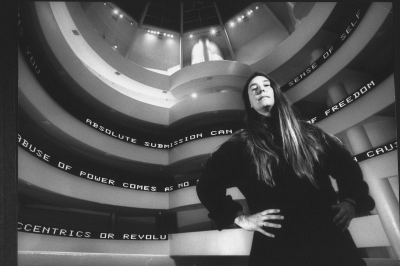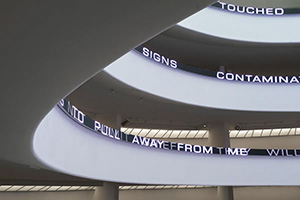“OUR TIMES ARE INTOLERABLE,” reads scrolling text that appears on a 900-foot-long LED screen mounted to the Guggenheim Museum’s rotunda right now. And who’s to disagree these days? Those words were first written by artist Jenny Holzer roughly 40 years ago, and she’s now recycled them anew, as if to suggest that not much has changed. For Holzer, it’s the same shit, different millennium.
When Holzer exhibited similar dictums via a screen mounted to the Guggenheim’s spiraling ramp into 1989, critics praised her for bringing new modes of communication into the walls of museums. Thirty-five years on, she has returned to the project, this time with the help of AI technology to create new digital effects.
This work, titled Installation for the Solomon R. Guggenheim Museum (1989/2024), initially appeared as stock ticker–like flow of commands and phrases in green, red, and yellow. Today, Holzer’s words linger behind blue fog, disintegrate into pixels, and leave behind menacing flares. The technology has been updated, but the maxims remain largely unchanged. Unfortunately, the sentiments feel more dated than ever.
Many of Holzer’s axioms function like bizarre advice or insidious directives: “STARVATION IS NATURE’S WAY,” “THE BEGINNING OF THE WAR WILL BE SECRET,” or the famed “PROTECT ME FROM WHAT I WANT” from Holzer’s “Truisms” series. They exude ennui: desires are boring, war is a constant, and no one can be trusted.

Five decades ago, Holzer began pushing these made-up idioms, printed in the sans-serif typeface associated with advertising, into public spaces via posters and T-shirts. She embraced the language of power, as seen on screens and in the media, and aspired to expose the evil that existed beneath its platitudes. The challenging thing about her work was its attractiveness: pictures of a flinty woman wearing Holzer’s “ABUSE OF POWER COMES AS NO SURPRISE” tank top continue to go viral for a reason.
But now, the coolness of Holzer’s art—its icy interior, its beautiful exterior—feels inappropriately glib. Words like Holzer’s appear daily on social media feeds. No one needs her art to understand how power works anymore—all one must do to figure that out is simply log on to X or TikTok. Her museum-filling Guggenheim exhibition, a survey of sorts, shows how this once-great artist went astray, failing to evolve her cold text for another era.

Holzer does, at least, seem keenly aware of what the internet has done to language. With Cursed (2022), one of the many recent works in this show, she exhibits a row of distressed, unevenly edged metal plates that run along a wall before collapsing in a pile on the floor. Each plate is printed with a different Donald Trump tweet, from ones addressing Russia’s involvement in his election to ones that preceded the January 6 insurrection he fomented into being. Their cruddy look runs counter to Twitter’s sleek aesthetic, as if to suggest the relics of a ruined civilization.
But now, the coolness of Holzer’s art—its icy interior, its beautiful exterior—feels inappropriately glib. Words like Holzer’s appear daily on social media feeds. No one needs her art to understand how power works anymore—all one must do to figure that out is simply log on to X or TikTok. Her museum-filling Guggenheim exhibition, a survey of sorts, shows how this once-great artist went astray, failing to evolve her cold text for another era.
